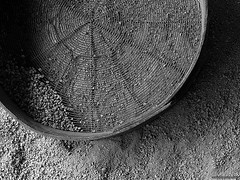There is a guy named Felix Stoffel somewhere in Switzerland who calls himself a "communications analysts" and now he released a press text on primes and their determinism. The headline sounds great:
Primes finally completely defined (translation by Google)
 Photo by mainblancheThe text is currently only available in German but after reading it, it turned out that he only reinvented the Sieve of Erathostenes, attributed to a ancient Greek mathematician who is never mentioned anywhere in the whole text.
The first half of the press text tries to use complicated philosophical language and overly complex mathematical constructs to irritate the reader while the second part drifts off into babbling about ore harvest on the moon and quantum-gravity.
Photo by mainblancheThe text is currently only available in German but after reading it, it turned out that he only reinvented the Sieve of Erathostenes, attributed to a ancient Greek mathematician who is never mentioned anywhere in the whole text.
The first half of the press text tries to use complicated philosophical language and overly complex mathematical constructs to irritate the reader while the second part drifts off into babbling about ore harvest on the moon and quantum-gravity.
Dear Felix Stoffel, whatever a "Kommunikationsanalytiker" (ger. for communications analysts) is to you but if that's what their output is, selling ancient inventions as their own, I'll put your job title on my esoteric-wackos list, next to the Orgon-chamber-manufacturer.
Anyone who is really interested in primes and their nature should start at Wikipedia.
Update: According to his profile, the author of this press text owns a PhD degree from the Commonwealth Open University which is listed as an unaccredited school by government authorities and is suspected of being a degree-mill.
I wanted to upgrade the BIOS of my desktop at work which is a Dell OptiPlex 960. Dell provides some minor help on flashing a new BIOS version under GNU/Linux but as of today it's outdated and unusable. Sadly they do not provide images for use with flashrom either, so one is stuck with their crappy .EXE files.
The OptiPlex 960 does no longer have a floppy drive (which is a good one ... Floppy is dead) so I had to come up with another way to boot a FreeDOS environment where I could run the .EXE provided by Dell.
I'm running GRUB2 so I'll use a method to automatically add images in the /boot/images/ folder to the boot-loader menu and run them.
I started by creating a suitable large file of let's say 10MB which has to reside in a separate folder on the partition GRUB2 uses for boot, usually /boot/:
mkdir /boot/images/
dd if=/dev/zero of=/boot/images/freedos.img bs=1M count=10
Now the image need to be made accessible as a loopback block-device:
losetup -f /boot/images/freedos.img
If you have no other loopback devices active you should have the image set up as /dev/loop0.
Now we need to download some boot-strapping files for our new FreeDOS environment and extract them:
mkdir /tmp/freedos/
cd /tmp/freedos/
wget http://www.ibiblio.org/pub/micro/pc-stuff/freedos/files/distributions/1.0/pkgs/commandx.zip
wget http://www.ibiblio.org/pub/micro/pc-stuff/freedos/files/distributions/1.0/pkgs/kernels.zip
wget http://www.ibiblio.org/pub/micro/pc-stuff/freedos/files/distributions/1.0/pkgs/substx.zip
wget http://www.ibiblio.org/pub/micro/pc-stuff/freedos/files/distributions/1.0/pkgs/unstablx.zip
for ZIP in *.zip; do unzip $ZIP; done
Next we create the filesystem for our new boot image and populate it with a FreeDOS system:
mkdir /tmp/fs-root/
cp ./bin/command.com /tmp/fs-root/
cp ./bin/kernel.sys /tmp/fs-root/
cp <path/to/bios/upgrade.EXE> /tmp/fs-root/
Call makebootfat to write the boot-straping sector and populate the image:
makebootfat -o /dev/loop0 -E 255 \
-1 /tmp/freedos/source/ukernel/boot/fat12.bin \
-2 /tmp/freedos/source/ukernel/boot/fat16.bin \
-3 /tmp/freedos/source/ukernel/boot/fat32lba.bin \
-m /usr/lib/syslinux/mbr.bin /tmp/fs-root/
Afterwards we can remove the loopback device:
losetup -d /dev/loop0
To boot the image you need the memdisk loader from syslinux present at /boot/ so it can load the image at boot time:
cp /usr/lib/syslinux/memdisk /boot/
That's it, the image should be ready for action. We just need to configure GRUB2 to automatically detect images in /boot/images/. Just copy the file from my Subversion repository and place it in /etc/grub.d/ and run update-grub2.
This should output something like this:
Found memdisk: /memdisk
Found floppy image: /images/freedos.img
Now reboot your machine and select the "freedos" option in the GRUB2 selection. Wait for the C: prompt and start upgrading your BIOS by running the .EXE provided by Dell.